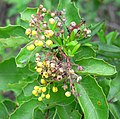Mahonia
| Mahonia | ||||||||||||
|---|---|---|---|---|---|---|---|---|---|---|---|---|

Common Oregon grape ( Mahonia aquifolium ) |
||||||||||||
| Systematics | ||||||||||||
|
||||||||||||
| Scientific name | ||||||||||||
| Mahonia | ||||||||||||
| Nutt. |
The Mahonien ( Mahonia ) is a plant genus in the family of Barberry (Berberidaceae). They are closely related to the barberries ( Berberis ) and have been classified in this genus by some botanists . Mahonia differ from barberries, for example, in their size, the lack of thorns and the pinnate leaves . The genus was named in honor of the Irish-American gardener Bernard M'Mahon .
description

Mahonia are evergreen shrubs without thorns . The alternate leaves are always pinnate unpaired and can be stalked or sessile. The leaflets are usually sessile and the edges can be smooth or toothed with thorns.
The simple or branched inflorescences are racemose or spiky. The yellow, threefold flowers have three sepal circles and two petal circles . The berries are blue to black and contain few seeds.
distribution
Mahonia is native to Asia , mainly eastern Asia, Southeast Asia and the Himalayas , as well as North , Central America and western South America. Of the 31 species found in China, 23 are endemic .
The typical representative of the genus is the common Oregon grape ( Mahonia aquifolium ), which is native to the Pacific coast of North America. In the temperate latitudes it is planted as an ornamental plant in parks and gardens; in large areas it occurs as a neophyte feral.
use
Some species of Mahonia are popular garden shrubs because of their decorative leaves, yellow flowers, and blue-black berries. The berries of some types are edible and are suitable for making jams , jellies and fruit wine .
History of the genus Mahonia

Mahonia japonica was the first Oregon grape , then still under the name Ilex iaponica , to be described by the Swedish naturalist Carl Peter Thunberg in 1784; the relationship of this new species with already known species of the genus Berberis was not recognized.
The first "barberry with pinnate leaves" - today Mahonia pinnata - was described in 1803 by Mariano Lagasca as Berberis pinnata . Finally, in 1817, Constantine S. Rafinesque-Schmaltz described the plant genus Odontostemon , which today corresponds to the genus Mahonia , but obviously did not gain acceptance.
The scientific genus name Mahonia was established in 1818 by the American botanist Thomas Nuttall and honors the Irish-American gardener Bernard M'Mahon (1775-1816). At that time the two species Mahonia aquifolium and Mahonia nervosa were included, which were described by Frederick Traugott Pursh in 1814 and initially assigned to the genus Berberis .
In 1824 six species of the plant genus Mahonia were described, including Mahonia japonica . Various authors subsequently reunited Berberis and Mahonia , mostly citing the plant genus Berberis with the subgenera Euberberis (with simple leaves) and Mahonia (with pinnate leaves).
Differences between Mahonia and Barberries
The two plant genera Mahonia and Berberis are closely related; Some botanists put them together in the plant genus Berberis . However, Mahonia differ from barberries in that they always have paniculate inflorescences, the evergreen, unpaired pinnate leaves, the lack of thorns and the fact that the nectar glands are not located on the petals but in pairs on the stamens, so that a division into two genera is entirely justified.
species
There are approximately 60 to 70 species of Mahonia (selection):
|
|
photos
swell
literature
- Junsheng Ying, David E. Boufford, Anthony R. Brach: Mahonia. In: Wu Zheng-yi, Peter H. Raven, Deyuan Hong (Eds.): Flora of China . Volume 19: Cucurbitaceae through Valerianaceae, with Annonaceae and Berberidaceae . Science Press / Missouri Botanical Garden Press, Beijing / St. Louis 2011, ISBN 978-1-935641-04-9 , pp. 772 (English, online ).
- Andreas Roloff, Andreas Bärtels: Flora of the woods. Purpose, properties and use . With a winter key from Bernd Schulz. 2nd completely revised edition. Eugen Ulmer, Stuttgart (Hohenheim) 2006, ISBN 3-8001-4832-3 .
- Robert Zander : Zander. Concise dictionary of plant names. Edited by Walter Erhardt , Erich Götz, Nils Bödeker, Siegmund Seybold . 17th edition. Eugen Ulmer, Stuttgart 2002, ISBN 3-8001-3573-6 .
- Walter Erhardt , Erich Götz, Nils Bödeker, Siegmund Seybold: The great pikeperch. Encyclopedia of Plant Names. Volume 2. Types and varieties. Eugen Ulmer, Stuttgart (Hohenheim) 2008, ISBN 978-3-8001-5406-7 .
use
- Paul Arauner: homemade wines and juices, liqueurs and schnapps. Falken, Niedernhausen 1985, ISBN 3-8068-0702-7 .
Individual evidence
- ^ A b Friedrich Fedde: Attempt a monograph of the genus Mahonia. In: Botanical yearbooks for systematics, plant history and plant geography. Volume 31, No. 1-2, 1902, pp. 30-133, digitized .
- ^ Friedrich Markgraf: Illustrated flora of Central Europe. Founded by Gustav Hegi , 2nd edition. Volume IV, part 1 Dicotyledones 2nd part (Berberidaceae, Lauraceae, Rhoeadales) , Carl Hanser, Munich 1958, p. 3.
- ↑ a b c d e f g h i j k l Mahonia in the Germplasm Resources Information Network (GRIN), USDA , ARS , National Genetic Resources Program. National Germplasm Resources Laboratory, Beltsville, Maryland. Retrieved January 31, 2017.
Web links
- The genus Mahonia in floras from different countries on eFloras.org








